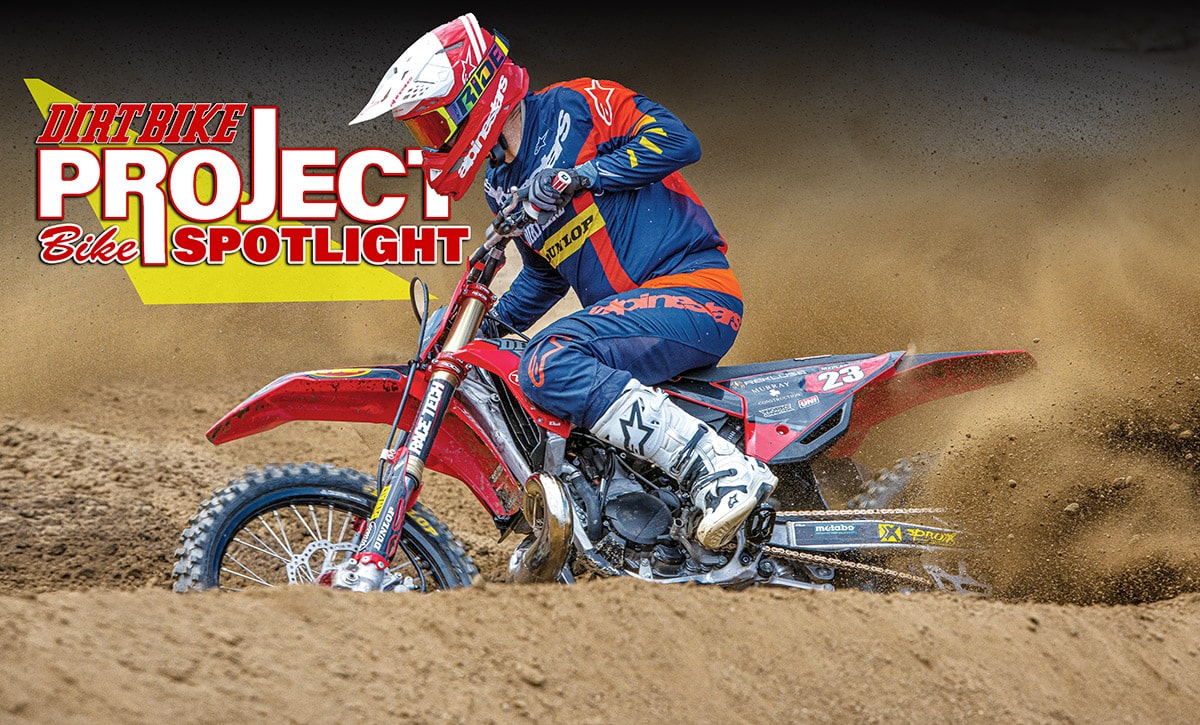Honda officially stopped making two-stroke motorcycles over a decade ago, and we don’t see any signs of that changing in the near future. The Honda two-stroke faithful have started taking matters into their own hands with CR500 250 and 125 conversions, but John Murray has taken it to the next level with his KTM 300SX two-stroke-powered Honda CRF450R conversion that we call “Under Construction.”
John Murray is a self-proclaimed “Honda guy” and is just one of the thousands of people around the world who would absolutely love if Honda started producing two-stroke competition motorcycles again. Now, Murray is not an engineer, but when he isn’t running the family business—Murray Construction, which is located in the eastern United States—he is riding dirt bikes or tinkering on dirt bikes in his garage.
Predominately a tight-woods rider, Murray naturally has spent time on new KTM two-strokes and started thinking about combining his love for Hondas with a modern, fuel-injected, electric-start two-stroke engine platform. Lucky for us, Murray couldn’t get this thought out of his head, along with the fact that he just happened to have both a 2023 Honda CRF450R and a 2023 KTM 300SX sitting in his garage.
In a matter of hours, he and a couple of friends had both bikes torn down with some very rough measurements being made. Naturally, the KTM engine would not just bolt right into the aluminum frame of the Honda, but it was surprising how close the fitment actually was. The intake system would have to be reconfigured because of the downdraft-type design of the Honda, and some main-frame modifications would also be needed to clear the KTM two-stroke cases just in front of the swingarm pivot to ensure proper engine placement and drivetrain alignment. They hadn’t even attempted to mount up an exhaust system or figure out where to locate the electronics, but that’s when Murray realized his idea was becoming a reality.
The entire 2023 Honda CRF450R chassis remained relatively intact with no major cutting or welding required, and there was some grinding done to the main frame, which we mentioned before. New engine brackets had to be made, along with pipe mounts that were bolted up to the original OEM Honda mounting points. Coolant hose routing got a little tricky, requiring some interesting real-world solutions with additions of “Y” connections in places, but no major radiator modifications were required. Just like the rest of the machine, the air-intake system utilizes both the KTM and Honda components with some what we like to call “real-world application techniques.”
FMF makes exhausts for just about anything, but don’t expect to find this application on their website. This exhaust did receive modifications to match the angle of the exhaust port on the cylinder, so it didn’t hit the “Y” junction on the frame. Does it work? Yes. Will we start seeing KTM 300-powered Hondas everywhere?
In our opinion, no, but maybe not for the reasons you think. Bottom line: Building one usable bike out of two brand-new bikes gets expensive really quick! You can sell the unused parts to recuperate some of the cost and probably come pretty close to breaking even, but the average person isn’t going to bankroll that.
We are used to project bikes that are much more polished than John Murray’s CR300, but sometimes looks can be deceiving when it comes to actual performance of the finished product. Murray’s CR300 was a blast to ride, and we only had minor issues with the bike during testing that were quick and easy to fix. Our biggest problem was having to give the bike back after testing, knowing that it was going to be shipped thousands of miles away so we can’t ride it whenever we want to.
Is this what a modern-day Honda two-stroke could be? It’s highly possible, and we love that John Murray took matters into his own hands to give the world an idea of what the average guy can do in his garage with some determination and a vision. Thanks, John!









Comments are closed.